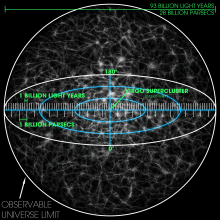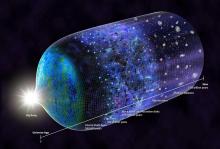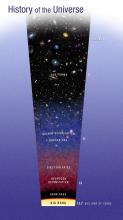Listen to today's episode of StarDate on the web the same day it airs in high-quality streaming audio without any extra ads or announcements. Choose a $8 one-month pass, or listen every day for a year for just $30.
You are here
Clearing the Fog
The earliest galaxies were a lot busier than their modern-day counterparts. They were giving birth to stars at a much faster rate. That included many stars that were especially hot and heavy. Those stars ended the cosmic “Dark Ages” — a period when the universe was dark and foggy.
The Dark Ages began soon after the Big Bang. The universe was filled with a “fog” of neutral hydrogen — atoms that blocked the glow of developing stars and galaxies. But the first hot, massive stars cleared away the fog.
Observations by Webb Space Telescope have allowed astronomers to see deeper into the Dark Ages than ever before. The telescope is large, and it’s above Earth’s atmosphere. The combination allows it to see the early universe more clearly than any other telescope in space or on the ground.
Webb revealed early galaxies up to 50 times fainter than any ever seen before. Those observations revealed the presence of certain chemical compounds. Those compounds are produced by the strong radiation from the hot young stars. The stars are dozens of times the Sun’s mass, tens of thousands of degrees hotter, and perhaps hundreds of thousands of times brighter.
Webb’s observations showed that early galaxies gave birth to these and other types of stars in giant outbursts — millions of stars at a time. The stars cleared up the fog — ending the cosmic Dark Ages.
Tomorrow: looking deeper into the early days of the Moon.
Script by Damond Benningfield






